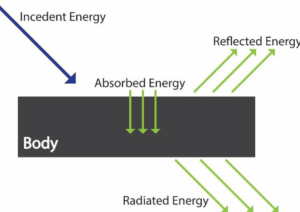Table of Contents
Absorptive Power :
The absorptive power of a body (or surface) is defined as the ratio of energy absorbed in a given time (or at a specific time) to the radiant energy incident on it at the same instant of time. It is a measurement of the amount of heat absorbed by an object. When heat is incident on the body’s surface, some of it is absorbed and some are reflected. As a result, absorptive power, a, equals the amount of energy absorbed divided by the amount of energy incident.
When heat is incident on the surface of an object, some of it is absorbed while the rest is reflected. A black body has an absorptive power of one because it absorbs the radiant energy of all wavelength incidents on it. A good absorber is also a good radiator. Typically, absorbed radiation is converted to thermal energy, raising the temperature of the object. For example, a Black body absorbs all incident radiation and has an absorptive power of one. As a result, the body with a higher absorptive power also has a higher emissive power. The amount of heat absorbed by the body is determined by its composition.
At a given temperature, a body’s absorptive power is defined, and wavelength is defined as the ratio of heat energy absorbed to heat energy incident on it in a wavelength range. This thermal energy is used by scientists to generate electricity. The most efficient method of converting low-grade heat into electricity is absorption. There are other applications as well. A small amount of heat is used to power the continuous-cycle absorption cooling unit. This heat is provided by natural gas, electricity, or kerosene.

Emissive Power
The amount of energy emitted per unit time per unit area of the surface for a given wavelength is defined as a body’s emissive power at a given temperature.
At any given temperature, it is the energy of thermal radiation emitted in all directions per unit time from each unit area of a surface. The emissive power of a body is defined as the ratio of energy emitted (or radiated) per unit area per second to the amount of heat energy emitted per unit area per second by a perfectly black body at the same temperature. When a body’s temperature rises above absolute zero, it emits heat, which is referred to as emission. When this emitted heat travels in the form of an electromagnetic wave, it is referred to as thermal radiation. At any given temperature, this power is the energy of thermal radiation emitted in all directions per unit time per unit area of a surface.
If ‘Q’ is the amount of radiant energy emitted, ‘A’ is the body’s surface area, and ‘t’ is the time for which the body radiates energy, the emissive power is –
E = Q/At
A body’s coefficient of emission is the ratio of its emissive power at a given temperature to that of a perfectly black body at the same temperature. The value of emissive power ranges from 0 to 1. A perfectly black body has an emissive power of 1. A perfectly white surface or body, on the other hand, has zero emissive power.
FAQs
What is the difference between absorptive and emissive power?
Emissive power is defined as the energy generated by thermal radiation emitted from the surface of a medium in all directions per unit time at a specific temperature. Absorptive power is defined as the energy ratio absorbed by a surface in a given time from incident energy.
What are the emissive and absorptive properties of black?
The difference between absorptive power and emissive power is that absorptive power is a type of ratio of energy absorbed to energy incident, whereas emissive power is the amount of thermal radiation emitted at a specific temperature overall wavelengths.



